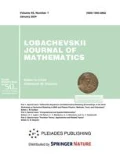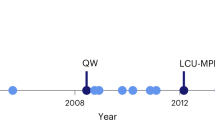Abstract
Due to complexity of the systems and processes it addresses, the development of computational quantum physics is influenced by the progress in computing technology. Here we overview the evolution, from the late 1980s to the current year 2020, of the algorithms used to simulate dynamics of quantum systems. We put the emphasis on implementation aspects and computational resource scaling with the model size and propagation time. Our mini-review is based on a literature survey and our experience in implementing different types of algorithms on supercomputers ‘‘Lobachevskii’’ (at Lobachevskii State University of Nizhny Novgorod) and ‘‘Lomonosov 2’’ (at Moscow State University).



Similar content being viewed by others
REFERENCES
K. B. Davis et al., ‘‘Bose-Einstein condensation in a gas of sodium atoms,’’ Phys. Rev. Lett. 75, 3969–3973 (1995).
R. Barendes et al., ‘‘Coherent Josephson qubit suitable for scalable quantum integrated circuits,’’ Phys. Rev. Lett. 11, 080502 (2013).
Ali W. Elshaari, W. Pernice, K. Srinivasan, O. Benson, and V. Zwiller, ‘‘Hybrid integrated quantum photonic circuits,’’ Nat. Photon. (2020, in press). https://doi.org/10.1038/s41566-020-0609-x
C. D. Bruzewicz, J. Chiaverini, R. McConnell, and J. M. Sage, ‘‘Trapped-ion quantum computing: Progress and challenges,’’ Appl. Phys. Rev. 6, 021314 (2019).
J. Yoneda et al., ‘‘A quantum-dot spin qubit with coherence limited by chargenoise and fidelity higher than 99.9%,’’ Nat. Nanotechnol. 13, 102–106 (2018).
N. Friis et al., ‘‘Observation of entangled states of a fully controlled 20-qubit system,’’ Phys. Rev. X 8, 021012 (2018).
Gartner: Hype Cycle Research Methodology. https://www.gartner.com/en/research/methodologies/gart- ner-hype-cycle. Accessed 2020.
‘‘Towards quantum attractors: computational physics of open quantum nanosystems far from equlibrium,’’ Russ. Sci. Foundation Project no. 15-12-20029 (2015–2017). https://www.rscf.ru/en/contests/search-projects/15-12-20029/.
‘‘Dissipative quantum chaos: categorization with high performance computing,’’ Russ. Sci. Foundation Project no. 19-72-20086 (2019–2022). https://www.rscf.ru/en/contests/search-projects/19-72-20086/.
V. I. Voevodin, A. Antonov, D. Nikitenko, P. Shvets, S. Sobolev, I. Sidorov, K. Stefanov, Vad. Voevodin, and S. Zhumatiy, ‘‘Supercomputer Lomonosov-2: Large scale, deep monitoring and fine analytics for the user community,’’ Supercomput. Front. Innov. 6, 4–11 (2019).
H.-P. Breuer and F. Petruccione, The Theory of Open Quantum Systems (Oxford Univ. Press, Oxford, 2002).
S. Kohler, J. Lehmann, and P. Hänggi, ‘‘Driven quantum transport on the nanoscale,’’ Phys. Rep. 406, 379–443 (2005).
R. Kosloff, ‘‘Propagation methods for quantum molecular dynamics,’’ Ann. Rev. Phys. Chem. 45, 145–178 (1994).
R. Bellman, Dynamic Programmings (Princeton Univ. Press, Princeton, 1957).
I. V. Oseledets and E. E. Tyrtyshnikov, ‘‘Breaking the curse of dimensionality, or how to use SVD in many dimensions,’’ SIAM J. Sci. Comput. 31, 3744–3759 (2009).
G. Vidal, ‘‘Efficient classical simulation of slightly entangled quantum computations,’’ Phys. Rev. Lett. 91, 147902 (2003).
J. Haegeman et al., ‘‘Time-dependent variational principle for quantum lattices,’’ Phys. Rev. Lett. 107, 070601 (2011).
J. Haegeman, C. Lubich, I. Oseledets, B. Vandereycken, and F. Verstraete, ‘‘Unifying time evolution and optimization with matrix product states,’’ Phys. Rev. B 94, 165116 (2016).
B. Kloss, Y. Bar Lev, and D. Reichman, ‘‘Time-dependent variational principle in matrix-product state manifolds: Pitfalls and potential,’’ Phys. Rev. B 97, 024307 (2018).
IBM Q Experience. https://www.ibm.com/quantum-computing/technology/experience/. Accessed 2020.
J. Preskill, ‘‘Quantum computing in the NISQ era and beyond,’’ Quantum 2, 79 (2018).
D. W. Berry et al., ‘‘Simulating Hamiltonian dynamics with a truncated Taylor series,’’ Phys. Rev. Lett. 114, 090502 (2015).
G. H. Low and I. L. Chuang, ‘‘Optimal Hamiltonian simulation by quantum signal processing,’’ Phys. Rev. Lett. 118, 010501 (2017).
G. H. Low and I. L. Chuang, ‘‘Hamiltonian simulation by qubitization,’’ Quantum 3, 163 (2019).
S. Lloyd, ‘‘Universal quantum simulators,’’ Science (Washington, DC, U. S.) 273, 1073 (1996).
G. Carleo et al., ‘‘Machine learning and the physical sciences,’’ Rev. Mod. Phys. 91, 045002 (2019).
G. Carleo and M. Troyer, ‘‘Solving the quantum many-body problem with artificial neural networks,’’ Science (Washington, DC, U. S.) 355, 602–606 (2017).
I. López-Gutiérrez and C. B. Mendl, ‘‘Real time evolution with neural-network quantum states,’’ arXiv:1912.08831 (2019).
M. Scmitt and M. Heyl, ‘‘Quantum many-body dynamics in two dimensions with artificial neural networks,’’ arXiv:1912.08828 (2019).
T. V. Laptyeva et al., ‘‘Calculating floquet states of large quantum systems: A parallelization strategy and its cluster implementation,’’ Comput. Phys. Commun. 201, 85–94 (2016).
A. Liniov et al., ‘‘Unfolding a quantum master equation into a system of real-valued equations: Computationally effective expansion over the basis of SU (N) generators,’’ Phys. Rev. E 100, 053305 (2019).
I. Meyerov et al., ‘‘Transforming the Lindblad equation into a system of linear equations: Performance optimization and parallelization,’’ arXiv: 1912.01491 (2019).
M. Ẑnidarič, A. Scardicchio, and V. K. Varma, ‘‘Diffusive and subdiffusive spin transport in the ergodic phase of a many-body localizable system,’’ Phys. Rev. Lett. 117, 040601 (2016).
V. Volokitin et al., ‘‘Propagating large open quantum systems towards their asymptotic states: Cluster implementation of the time-evolving block decimation scheme,’’ J. Phys.: Conf. Ser. 1392, 012061 (2019).
N. Auer et al., ‘‘Magnus integrators on multicore CPUs and GPUs,’’ Comput. Phys. Commun. 228, 115–122 (2018).
J. R. Johansson, P. D. Nation, and F. Nori, ‘‘QuTiP 2: A Python framework for the dynamics of open quantum systems,’’ Comput. Phys. Commun. 184, 1234–1240 (2013).
K. Björnson, ‘‘TBTK: A quantum mechanics software development kit,’’ SoftwareX 9, 205–210 (2019).
B. Schmidt and U. Lorenz, ‘‘WavePacket: A Matlab package for numerical quantum dynamics. I: Closed quantum systems and discrete variable representations,’’ Comput. Phys. Commun. 213, 223–234 (2017).
B. Schmidt and C. Hartmann, ‘‘WavePacket: A Matlab package for numerical quantum dynamics. II: Open quantum systems, optimal control, and model reduction,’’ Comput. Phys. Commun. 228, 229–244 (2018).
C. S. Bederián and A. D. Dente, ‘‘Boosting quantum evolutions using Trotter-Suzuki algorithms on GPUs,’’ in Proceedings of HPCLatAm-11, 4th High-Performance Computing Symposium, Cordoba, Argentina, 2011.
T. Auckenthaler et al., ‘‘Matrix exponentials and parallel prefix computation in a quantum control problem,’’ Parallel Comput. 36, 359–369 (2010).
D. Jaschke, M. L. Wall, and L. D. Carr, ‘‘Open source matrix product states: Opening ways to simulate entangled many-body quantum systems in one dimension,’’ Comput. Phys. Commun. 225, 59–91 (2018).
P. Wittek and F. M. Cucchietti, ‘‘A second-order distributed Trotter-Suzuki solver with a hybrid CPU-GPU kernel,’’ Comput. Phys. Commun. 184, 1165–1171 (2013).
P. Wittek and L. Calderaro, ‘‘Extended computational kernels in a massively parallel implementation of the Trotter-Suzuki approximation,’’ Comput. Phys. Commun. 197, 339–340 (2015).
S. Blanes et al., ‘‘The Magnus expansion and some of its applications,’’ Phys. Rep. 470, 151–238 (2009).
C. Moler and C. van Loan, ‘‘Nineteen dubious ways to compute the exponential of a matrix, twenty-five years later,’’ SIAM Rev. 45, 3–49 (2003).
Y. Saad, ‘‘Analysis of some Krylov subspace approximations to the matrix exponential operator,’’ SIAM J. Numer. Anal. 29, 209–228 (1992).
D. Jaschke and L. D. Carr, ‘‘Open source matrix product states: Exact diagonalization and other entanglement-accurate methods revisited in quantum systems,’’ J. Phys. A: Math. Theor. 51, 465302 (2018).
M. Brenes et al., ‘‘Massively parallel implementation and approaches to simulate quantum dynamics using Krylov subspace techniques,’’ Comput. Phys. Commun. 235, 477–488 (2019).
H. Samet, Foundations of Multidimensional and Metric Data Structures (Morgan Kaufmann, 2006).
U. Schollwoeck, ‘‘The density-matrix renormalization group in the age of matrix product states,’’ Ann. Phys. 326, 96 (2011).
P. Secular, N. Gourianov, M. Lubasch, S. Dolgov, S. R. Clark, and D. Jaksch, ‘‘Parallel time-dependent variational principle algorithm for matrix product states,’’ arXiv:1912.06127 (2019).
R. P. Feynman, ‘‘Simulating physics with computers,’’ Int. J. Theor. Phys. 21, 467–488 (1982).
A. M. Childs et al., ‘‘Toward the first quantum simulation with quantum speedup,’’ Proc. Natl. Acad. Sci. U. S. A. 115, 9456 (2019).
QuEST—Quantum Exact Simulation Toolkit. https://quest.qtechtheory.org/. Accessed 2020.
T. Jones, A. Brown, I. Bush, and S. C. Benjami, ‘‘QuEST and high performance simulation of Quantum Computer,’’ Sci. Rep. 9, 1073 (2019).
Zhih-Ahn Jia et al., ‘‘Quantum neural network states: A brief review of methods and applications,’’ Adv. Quantum Technol., 1800077 (2019).
I. Glasser, N. Pancotti, M. August, I. D. Rodriguez, and J. I. Cirac, ‘‘Neural-network quantum states, string-bond states, and chiral topological states,’’ Phys. Rev. X 8, 011006 (2018).
List of QC simulators. https://quantiki.org/wiki/list-qc-simulators. Accessed April 2020.
A. S. Green et al., ‘‘Quipper: A scalable quantum programming language,’’ in Proceedings of the 34th ACM SIGPLAN Conference on Programming Language Design and Implementation, 2013, pp. 333–342.
A. W. Cross et al., ‘‘Open quantum assembly language,’’ arXiv:1707.03429 (2017).
K. Svore et al., ‘‘Q# Enabling scalable quantum computing and development with a high-level DSL,’’ in Proceedings of the Real World Domain Specific Languages Workshop 2018 (2018), pp. 1–10.
A. J. Abhari et al., ‘‘Scaffold: Quantum programming language,’’ TR-934-12 (2012).
G. Guerreschi et al., ‘‘Intel Quantum Simulator: A cloud-ready high-performance simulator of quantum circuits,’’ arXiv:2001.10554 (2020).
M. Smelyanskiy, N. P. Sawaya, and A. Aspuru-Guzik, ‘‘qHiPSTER: the quantum high performance software testing environment,’’ arXiv:1601.07195 (2016).
G. Aleksandrowicz et al., ‘‘Qiskit: An open-source framework for quantum computing,’’ https://zenodo.org/record/2562111. Accessed April 2020.
M. Amy and V. Gheorghiu, ‘‘staq–A full-stack quantum processing toolkit,’’ arXiv:1912.06070 (2019).
A. B. de Avila et al., ‘‘State-of-the-art quantum computing simulators: Features, optimizations, and improvements for D-GM,’’ Neurocomputing (2019).
T. Häner and D. S. Steiger, ‘‘5 petabyte simulation of a 45-qubit quantum circuit,’’ in Proceedings of the International Conference for High Performance Computing, Networking, Storage and Analysis, 2017, pp. 1–10.
E. Pednault et al., ‘‘Breaking the 49-qubit barrier in the simulation of quantum circuits,’’ arXiv:1710.05867 (2017).
E. Pednault et al., On ‘‘Quantum Supremacy.’’ https://www.ibm.com/blogs/research/2019/10/on-quantum-supremacy/. Accessed 2020.
Z. Y. Chen, et al., ‘‘64-qubit quantum circuit simulation,’’ Sci. Bull. 63, 964-971 (2018).
I. Goodfellow, Y. Bengio, and A. Courville, Deep Learning (MIT Press, Boston, MA, 2016).
V. Volokitin, A. Liniov, I. Meyerov, M. Hartmann, M. Ivanchenko, P. Hänggi, and S. Denisov, ‘‘Computation of the asymptotic states of modulated open quantum systems with a numerically exact realization of the quantum trajectory method,’’ Phys. Rev. E 96, 053313 (2017).
A. Liniov, V. Volokitin, I. Meyerov, M. Ivanchenko, and S. Denisov, ‘‘Increasing performance of the quantum trajectory method by grouping trajectories,’’ Commun. Comput. Inform. Sci. 793, 136 (2017).
Increasing AI Performance and Efficiency with Intel DL Boost. https://www.intel.ai/increasing-ai-performance-intel-dlboost/#gs.117qh4. Accessed 2020.
Intel Unveils New GPU Architecture with High-Performance Computing and AI Acceleration. https://newsroom.intel.com/news-releases/intel-unveils-new-gpu-architecture-optimized-for-hpc-ai-oneapi/#gs.11dtfx. Accessed 2020.
Graphcore. https://www.graphcore.ai/. Accessed 2020.
T. Häner, D. S. Steiger, K. Svore, and M. Troyer, ‘‘A software methodology for compiling quantum programs,’’ Quantum Sci. Technol. 3, 020501 (2018).
S. Khatri et al., ‘‘Quantum-assisted quantum compiling,’’ Quantum 3, 140 (2019).
We use this word in its biological sense, as a cumulative inherited change in a population of organisms through time leading to the appearance of new forms, Dictionary, Merriam-Webster. https://www.merriam-webster.com/dictionary/evolution.
S. Lloyd, ‘‘Universal quantum simulators,’’ Science (Washington, DC, U. S.) 273, 1073 (1996).
B. Kloss, Y. Bar Lev, and D. Reichman, ‘‘Time-dependent variational principle in matrix-product state manifolds: Pitfalls and potential,’’ Phys. Rev. B 97, 024307 (2018).
S. Goto, and I. Danshita, ‘‘Performance of the time-dependent variational principle for matrix product states in the long-time evolution of a pure state,’’ Phys. Rev. B 99, 054307 (2019).
S. Paeckel et al., ‘‘Time-evolution methods for matrix-product states,’’ Ann. Phys. 411, 167998 (2019).
J. Jordan, R. Orús, G. Vidal, F. Verstraete, and J. I. Cirac, ‘‘Classical simulation of infinite-size quantum lattice systems in two spatial dimensions,’’ Phys. Rev. Lett. 101, 250602 (2008).
V. Murg, F. Verstraete, and J. I. Cirac, ‘‘Variational study of hard-core bosons in a two-dimensional optical lattice using projected entangled pair states,’’ Phys. Rev. A 75, 033605 (2007).
Ho N. Phien et al., ‘‘Infinite projected entangled pair states algorithm improved: Fast full update and gauge fixing,’’ Phys. Rev. B 92, 035142 (2015).
M. A. Nielsen and I. L. Chuang, Quantum Computation and Quantum Information (Cambridge Univ. Press, Cambridge, 2010).
Funding
The work is supported by the Russian Science Foundation via Grant no. 19-72-20086. The research is carried out using the equipment of the shared research facilities of HPC computing resources at Moscow State University [10] and the Lobachevskii supercomputer at Lobachevskii University.
Author information
Authors and Affiliations
Corresponding authors
Additional information
(Submitted by E. E. Tyrtyshnikov)
Rights and permissions
About this article
Cite this article
Meyerov, I., Liniov, A., Ivanchenko, M. et al. Modeling Complex Quantum Dynamics: Evolution of Numerical Algorithms in the HPC Context. Lobachevskii J Math 41, 1509–1520 (2020). https://doi.org/10.1134/S1995080220080120
Received:
Revised:
Accepted:
Published:
Issue Date:
DOI: https://doi.org/10.1134/S1995080220080120




